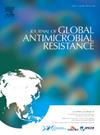First report of a carbapenem-resistant Aeromonas veronii environmental isolate in the United States co-harboring two carbapenemase genes
IF 3.7
3区 医学
Q2 INFECTIOUS DISEASES
引用次数: 0
Abstract
Objectives
The spread of carbapenem-resistant bacteria (CRB), and especially carbapenemase-producing CRB, is a global public health threat. Among them, Aeromonas species are of increasing concern because these emerging opportunistic pathogens are widespread in the environment and have increasingly been found to be resistant to carbapenems. The aim of this study was to investigate the genome and carbapenem-resistance determinants of Aeromonas veronii SS-M2–3, a highly carbapenem-resistant, carbapenemase-producing, river isolate from California (U.S.).
Methods
We first used disk diffusion assays to characterize the susceptibility profile to carbapenems and other antibiotics of A. veronii SS-M2–3. We next used whole-genome sequencing using the Illumina platform and bioinformatics analysis to characterize the resistome of this isolate and identify its carbapenemase genes.
Results
A. veronii SS-M2–3 was resistant to all carbapenems tested and amoxicillin-clavulanic acid, whereas it was sensitive to cefotaxime and all non-β-lactam antibiotics tested. Whole genome sequencing of this isolate revealed a complex resistome that included multidrug efflux pump genes and three chromosomal β-lactamase genes. These three genes encoded for highly conserved variants (82% to 97% amino acid identity) of the ChpA3 subclass B2 metallo-carbapenemase, OXA-12 class D carbapenemase and the FOX-2 class C β-lactamase. This is the first report of an environmental A. veronni isolate from the U.S. co-harbouring two carbapenemase genes.
Conclusions
These findings reveal that natural aquatic environments in the U.S. represent an underappreciated reservoir of carbapenem-resistant Aeromonas veronii isolates that can carry multiple carbapenemase genes.
首次报告美国环境中分离出的对碳青霉烯类耐药的维龙单胞菌同时携带两种碳青霉烯酶基因。
目标:耐碳青霉烯类细菌(CRB),尤其是产生碳青霉烯类酶的 CRB 的传播是对全球公共卫生的威胁。其中,气单胞菌日益受到关注,因为这些新出现的机会性病原体在环境中广泛存在,而且越来越多地被发现对碳青霉烯类产生耐药性。本研究的目的是调查维龙单胞菌 SS-M2-3 的基因组和碳青霉烯类耐药性决定因素:方法:我们首先使用磁盘扩散法分析了维罗纳弧菌 SS-M2-3 对碳青霉烯类和其他抗生素的敏感性。接下来,我们使用 Illumina 平台进行全基因组测序,并进行生物信息学分析,以确定该分离株的耐药基因组特征并鉴定其碳青霉烯酶基因:结果:A. veronii SS-M2-3对所测试的所有碳青霉烯类抗生素和阿莫西林-克拉维酸均耐药,而对头孢他啶和所测试的所有非β-内酰胺类抗生素均敏感。对该分离株的全基因组测序发现了一个复杂的抗药性基因组,其中包括多药外排泵基因和三个染色体β-内酰胺酶基因。这三个基因编码 ChpA3 B2 亚类金属碳青霉烯酶、OXA-12 D 类碳青霉烯酶和 FOX-2 C 类 β-内酰胺酶的高度保守变体(82%-97% 氨基酸同一性)。这是首次报道美国环境中的维龙尼甲虫分离物同时携带两种碳青霉烯酶基因:结论:这些研究结果表明,美国的自然水生环境是一个未得到充分重视的耐碳青霉烯类的维龙单胞菌分离物库,这些分离物可携带多种碳青霉烯类酶基因。
本文章由计算机程序翻译,如有差异,请以英文原文为准。
求助全文
约1分钟内获得全文
求助全文
来源期刊

Journal of global antimicrobial resistance
INFECTIOUS DISEASES-PHARMACOLOGY & PHARMACY
CiteScore
8.70
自引率
2.20%
发文量
285
审稿时长
34 weeks
期刊介绍:
The Journal of Global Antimicrobial Resistance (JGAR) is a quarterly online journal run by an international Editorial Board that focuses on the global spread of antibiotic-resistant microbes.
JGAR is a dedicated journal for all professionals working in research, health care, the environment and animal infection control, aiming to track the resistance threat worldwide and provides a single voice devoted to antimicrobial resistance (AMR).
Featuring peer-reviewed and up to date research articles, reviews, short notes and hot topics JGAR covers the key topics related to antibacterial, antiviral, antifungal and antiparasitic resistance.
 求助内容:
求助内容: 应助结果提醒方式:
应助结果提醒方式:


